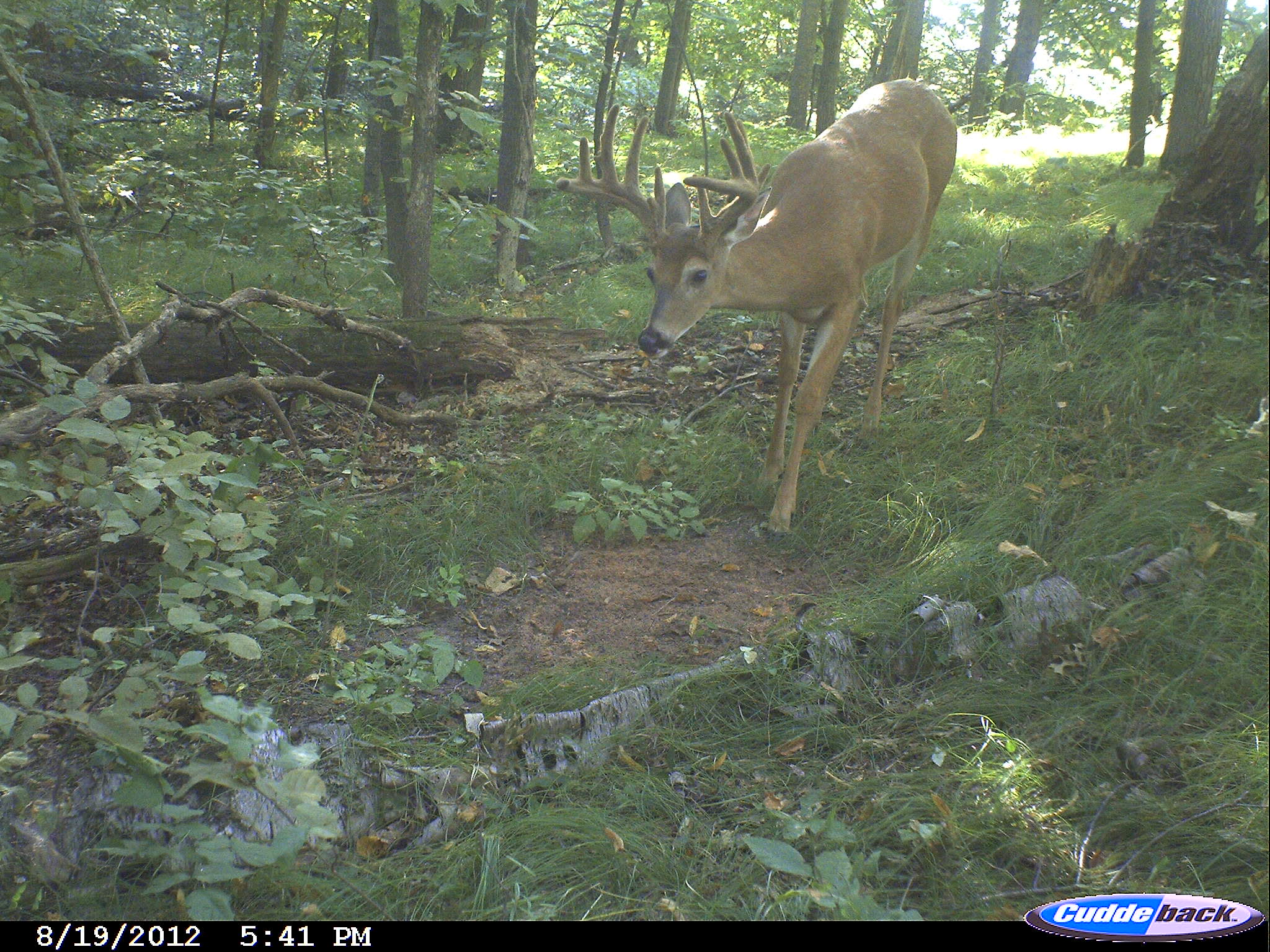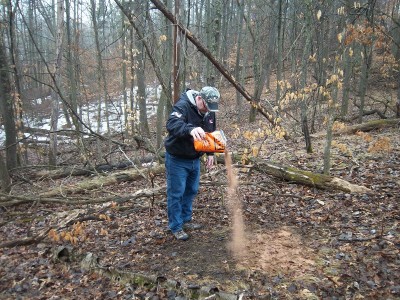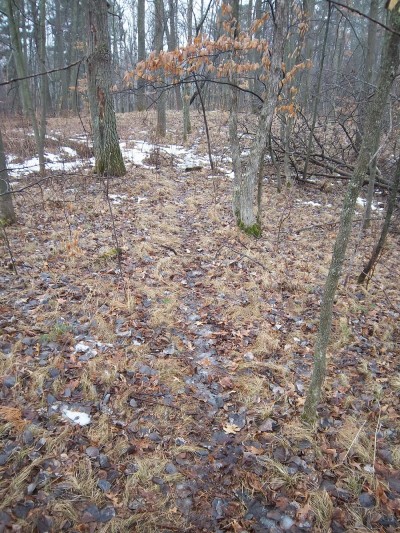Hunting Small Properties for Whitetails
Bernie Barringer 09.11.13

Finding small gems of hunting land can lead to great hunting opportunities most hunters would overlook.
The “deer in the headlights” look was probably the look on my face when I saw the deer in the headlights. I was rounding a curve when he appeared along the side of the road through a populated area. Wow! That’s a big buck for this area!
I live in a part of Minnesota where more than 80 percent of the bucks are shot when they are yearlings. It’s a significant source of frustration for me, and I could do an entire article on that topic, but it has tuned me in to the fact that the few mature bucks living in this state are often living in little out-of-the-way places where no one would think to hunt.
So when that big buck leapt from the roadside and into the woods, I knew I had to check out the area. Once home, I brought up the GIS data for my county on the computer and looked at the property lines and landowners for the area. The buck had disappeared into a small piece of wooded property that was sandwiched between a park and a line of homes surrounding a lake. The entire area had the look of great suburban deer habitat and the data showed me that this 15-acre piece of property was owned by a real estate developer.
All it took was one phone call and I was in. The owner said no one had ever asked to bowhunt there, but I was welcome to give it a whirl. Just like that.
Now I had to develop a strategy. Just exactly how do you hunt 15 acres situated in a large patchwork of homes, lakes, and pockets of whitetail cover? And is it really possible to think I had a chance to kill that buck on such a small patch of land? I haven’t killed that buck yet, but what I’ve learned from trying has helped me more effectively hunt these tiny properties. Here’s how I go about it.
Walk it out
A common theme in hunting these properties is being minimally intrusive with your presence and your scent. But I make an exception to that rule when I first acquire a piece of property. I like to cover it thoroughly and gather as much firsthand information as I can. I want to know where the beds are located, how the deer are travelling the topography, and what they are eating and where.
It’s rare that pieces of property this small would have both a bedding and a feeding area. Usually you get one or the other—or neither. But having both can be the case when you have good mast crops right on the property. When the acorns, locust pods, and hazelnuts are on the ground, the bedding area and the feeding area may be all together in one place. That’s an ideal situation for a small property.
For reasons I can’t fully explain, a lot of these small properties often tend to be transition areas between feeding and bedding locations. I have another one that is a staging area near a crop field. The field is normally in alfalfa. It’s a great early-season hunting spot because the bucks tend to hang out there for the last hour of daylight while the does move into the field.
The archery season here in Minnesota opens in mid-September. This particular 10-acre gem is terrific for the first two to three weeks of the season, until frosts have taken the appeal out of the alfalfa or the corn has been harvested. Then the deer simply have moved on to other foods, most often the mast crops.
These are all things I have learned from first exploring every inch of the property. Once you really get to know the property, you don’t have to do this again, but you do need to figure out what deer you have using the property.

Take inventory
The next thing you need to do is learn the potential. We need to find out which bucks are using the land and how often. I have found the best way to inventory the population is with game cameras monitoring trails and mineral licks. This two-pronged attack brings the deer to you with the mineral, and you go to the deer with the trail monitoring. The combination of the two assures that you get a picture of every deer on the property within a month or so.
This technique works the best if you start in the spring to early summer when the minerals are most attractive to the deer. Does and bucks alike use the mineral sites and you can watch the antlers grow throughout the summer. It is important to keep your intrusion and ground scent to a minimum. I recommend checking the cameras not more than once every two weeks, and once a month is better if you can stand to wait that long.
Keep in mind that deer using such a small area will be in a state of flux. A buck may be nearby, but may only visit the area with the cameras a couple times a summer. Don’t be discouraged, sometimes the bucks that aren’t living on the property are easier to kill since the ones that actually spend the majority of their time on that patch of ground have the best chance to pattern you.
Don’t panic if you seem to be getting pictures of lots of does, but few bucks other than yearlings. There is nothing wrong with being in the home range of a bunch of does, because the time of year will come when being around a lot of does is a very good thing.
Make improvements
If you find that you have a bedding area on the property, you can make improvements to increase the attractiveness of it. Hinging trees and opening up the canopy to let more undergrowth thrive are two ways to do that, assuming you have permission to do so. Keep in mind that cutting trees can be one of the fastest ways to lose permission if the landowner doesn’t know exactly why you are doing it. Get approval in advance of making any significant changes to the property. The old saying that it’s easier to ask forgiveness than permission definitely does not apply here.
Another thing that I have found to be successful is making deer beds. Bucks like to lie with something at their back in an area they can have a view downwind. They don’t like to lie on sticks and pebbles so you can clean off the ground in a few areas and actually get the deer to use the specific beds you have created. Fallen logs or some of your hinge-cut trees make great backstops for self-made deer beds.
The more time you can get the deer to spend on your property, the better your odds of bagging them. Improving bedding habitat is one of the best ways to do that.
Little things can make a big difference. I once had a big oak tree fall across one of the main trails on my small property during a summer storm. The deer funneled around it and eventually created a new network of trails that mostly took them off the property! By the time I realized what was going on I was losing much of my deer activity. I took a chainsaw and cut through a few limbs of that giant old tree, making a pathway through it, and soon the deer were back to their old ways.
No trespassing
On that little 15-acre property by the park, I started getting pictures of does and small bucks right away, but I also got a picture of a kid on a mountain bike, a woman walking her dog, a guy that appeared to be mushroom hunting, and another guy carrying a fishing rod. There is no question that deer living in these types of environments get somewhat acclimated to human scent but this was a little ridiculous. If I wanted to get any daylight activity from mature bucks, I needed to keep out the riffraff.
“No Trespassing” signs helped a little, but actually just spreading the word around the neighborhood that the land was private and entering it was against the law had the most affect. I met the woman with the dog on the road walking one day and I kindly explained to her that the land was not public land but the park was. She got the message.

Time to hunt
Now that we have our property improved and scouted, we know it like the back of our hand. We know what bucks are using it and have a rough idea of when and where they are travelling through. We have a couple treestands up and we are ready to put an arrow in a buck. But hold on! Patience is critically important when the season opens.
The first year I hunted that new piece of property by the park, I watched as people came and went, walking through the park and sometimes on the property. I even had a trail camera stolen. One of the treestands I put up was on a heavily-used trail along the top of a ridge only 60 yards from the park’s asphalt walking trail. It was obvious that the deer didn’t react with panic each time they encountered human scent; if they had they would be in a panic every day.
But I made the mistake of thinking that would allow me to get away with risks I wouldn’t take on other properties with less human activity. Looking back at that first year, the benefit of hindsight tells me that I significantly reduced my chances of bagging a mature buck by taking chances with the wind, and sneaking out to the stand after work when I really shouldn’t have been moving through the property. These deer get really good at determining if a person is out for a stroll or if they have more sinister intentions. I do not know how they know, but they seem to know.
Truth is you can wreck the fragile potential of a tiny property by making one mistake. I now have two stands on that 15 acres, one for a wind with some east to southeast to it and one for winds from the west and northwest. I don’t hunt them if the conditions are not perfect. No exceptions. One of my stands is only 100 yards from the road, but to approach it correctly, I walk all the way around through the park and enter from the opposite side. It’s about one-third of a mile of extra effort, but one of these days it will make the difference between seeing a bobbing white tail versus a red arrow.
I have yet to shoot a buck off that 15-acre gem of deer habitat but I have had some close calls. Maybe this is the year one of the three mature bucks using it will be going home with me. Their names are Crazy Eight, Stickers, and Gnarley. I feel like I know them better than they know themselves.
Small properties in the right locations can be amazing gems. Yet, I would be a fool to think that I could hold deer on a property of 30 acres or smaller. It’s simply not going to happen, but by using my suggestions I believe you will agree that you can increase your odds of getting a shot at a buck on that property. Tread lightly and always think of the deer activity on that property as a very fragile thing that can be broken easily. Consider this outlook each time you are drooling over a trail camera picture of a nice buck. Resolve to do it the right way—you will eventually be rewarded for your diligence.
Follow Bernie’s bowhunting adventures on his blog, bowhuntingroad.com.

